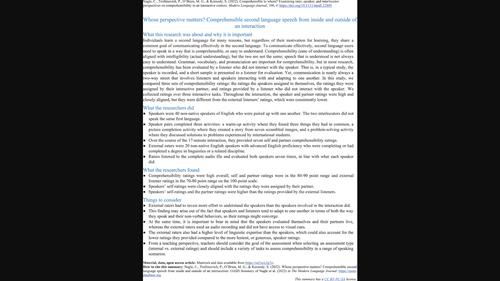当前位置:
X-MOL 学术
›
Mod. Lang. J.
›
论文详情
Our official English website, www.x-mol.net, welcomes your
feedback! (Note: you will need to create a separate account there.)
Comprehensible to Whom? Examining Rater, Speaker, and Interlocutor Perspectives on Comprehensibility in an Interactive Context
The Modern Language Journal ( IF 4.7 ) Pub Date : 2022-11-20 , DOI: 10.1111/modl.12809 CHARLIE L. NAGLE 1 , PAVEL TROFIMOVICH 2 , MARY GRANTHAM O'BRIEN 3 , SARA KENNEDY 4
The Modern Language Journal ( IF 4.7 ) Pub Date : 2022-11-20 , DOI: 10.1111/modl.12809 CHARLIE L. NAGLE 1 , PAVEL TROFIMOVICH 2 , MARY GRANTHAM O'BRIEN 3 , SARA KENNEDY 4
Affiliation

|
Comprehensibility has emerged as a useful and intuitive means of globally evaluating second language (L2) speakers in many research and instructional contexts. In most cases, L2 speakers’ comprehensibility is assessed by external listeners who do not engage in extensive communication with the speakers, even though the degree to which a speaker is comprehensible is presumably of greatest concern to their interlocutor. If comprehensibility is defined as the ease with which speakers come to understand one another, then interaction-based assessments, which would include self and peer ratings, might provide different insight into interactive comprehensibility compared to assessments by external listeners. To examine this issue, in this study, 20 pairs of L2 English interactants rated themselves and their partner on 7 occasions distributed throughout a 17-minute interaction encompassing 3 communicative tasks, and recordings of the interaction were subsequently presented to external raters for evaluation. Mixed-effects models were used to compare the shape of the comprehensibility curves over time and the self, partner, and rater scores at each rating episode. Results demonstrated that self and partner assessments were always aligned, but raters consistently assigned significantly lower comprehensibility scores to the interactants. These findings have implications for how comprehensibility, and indeed other listener-based constructs, are assessed.
中文翻译:

谁能理解?在交互环境中检查评分者、演讲者和对话者对可理解性的看法
在许多研究和教学环境中,可理解性已成为全球评估第二语言 (L2) 使用者的一种有用且直观的方法。在大多数情况下,L2 说话者的可理解性是由不与说话者进行广泛交流的外部听众评估的,即使说话者的可理解程度可能是他们的对话者最关心的。如果可理解性被定义为说话者相互理解的难易程度,那么与外部听众的评估相比,基于交互的评估(包括自我和同行评分)可能会提供对交互可理解性的不同见解。为了研究这个问题,在这项研究中,20 对 L2 英语交互者在 7 种情况下对自己和他们的合作伙伴进行评分,分布在 17 分钟的交互中,包括 3 项交际任务,随后将交互录音提供给外部评分者进行评估。混合效应模型用于比较随时间变化的可理解性曲线的形状以及每个评分情节中自我、合作伙伴和评分者的分数。结果表明,自我和合作伙伴的评估始终保持一致,但评分者始终为交互者分配显着较低的可理解性分数。这些发现对如何评估可理解性以及其他基于听众的结构具有影响。互动的录音随后被提交给外部评分员进行评估。混合效应模型用于比较随时间变化的可理解性曲线的形状以及每个评分情节中自我、合作伙伴和评分者的分数。结果表明,自我和合作伙伴的评估始终保持一致,但评分者始终为交互者分配显着较低的可理解性分数。这些发现对如何评估可理解性以及其他基于听众的结构具有影响。互动的录音随后被提交给外部评分员进行评估。混合效应模型用于比较随时间变化的可理解性曲线的形状以及每个评分情节中自我、合作伙伴和评分者的分数。结果表明,自我和合作伙伴的评估始终保持一致,但评分者始终为交互者分配显着较低的可理解性分数。这些发现对如何评估可理解性以及其他基于听众的结构具有影响。但是评分者始终给交互者分配明显较低的可理解性分数。这些发现对如何评估可理解性以及其他基于听众的结构具有影响。但是评分者始终给交互者分配明显较低的可理解性分数。这些发现对如何评估可理解性以及其他基于听众的结构具有影响。
更新日期:2022-11-20
中文翻译:

谁能理解?在交互环境中检查评分者、演讲者和对话者对可理解性的看法
在许多研究和教学环境中,可理解性已成为全球评估第二语言 (L2) 使用者的一种有用且直观的方法。在大多数情况下,L2 说话者的可理解性是由不与说话者进行广泛交流的外部听众评估的,即使说话者的可理解程度可能是他们的对话者最关心的。如果可理解性被定义为说话者相互理解的难易程度,那么与外部听众的评估相比,基于交互的评估(包括自我和同行评分)可能会提供对交互可理解性的不同见解。为了研究这个问题,在这项研究中,20 对 L2 英语交互者在 7 种情况下对自己和他们的合作伙伴进行评分,分布在 17 分钟的交互中,包括 3 项交际任务,随后将交互录音提供给外部评分者进行评估。混合效应模型用于比较随时间变化的可理解性曲线的形状以及每个评分情节中自我、合作伙伴和评分者的分数。结果表明,自我和合作伙伴的评估始终保持一致,但评分者始终为交互者分配显着较低的可理解性分数。这些发现对如何评估可理解性以及其他基于听众的结构具有影响。互动的录音随后被提交给外部评分员进行评估。混合效应模型用于比较随时间变化的可理解性曲线的形状以及每个评分情节中自我、合作伙伴和评分者的分数。结果表明,自我和合作伙伴的评估始终保持一致,但评分者始终为交互者分配显着较低的可理解性分数。这些发现对如何评估可理解性以及其他基于听众的结构具有影响。互动的录音随后被提交给外部评分员进行评估。混合效应模型用于比较随时间变化的可理解性曲线的形状以及每个评分情节中自我、合作伙伴和评分者的分数。结果表明,自我和合作伙伴的评估始终保持一致,但评分者始终为交互者分配显着较低的可理解性分数。这些发现对如何评估可理解性以及其他基于听众的结构具有影响。但是评分者始终给交互者分配明显较低的可理解性分数。这些发现对如何评估可理解性以及其他基于听众的结构具有影响。但是评分者始终给交互者分配明显较低的可理解性分数。这些发现对如何评估可理解性以及其他基于听众的结构具有影响。











































 京公网安备 11010802027423号
京公网安备 11010802027423号